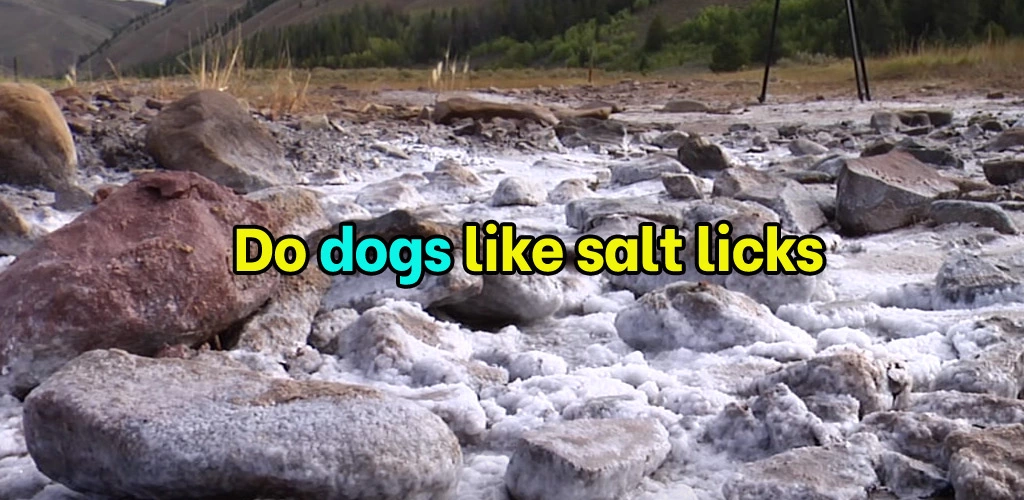Does my dog need a salt lick? While salt is one of the most important nutrients for all animals, it is must to know first whether it will be good for your dog or not.
Table of Contents
Does your dog need salt licks
For the longest time, the area of nutrition has been filled with lots of conflicting data and information. Consider nutrition advice for humans, for instance. While keto claims that the ultimate enemies are carbs, there are other diet plans stating that you can lose weight If you have a high carb intake, saying that fat is the real culprit behind weight problems.

The same kind of conflicting information is applicable to dog nutrition. If you are a pet owner, you will surely find some sources saying that salt licks are necessary for dogs, while others are completely against it.
This question is not really easy to answer as there are still many things you need to know as far as salt licks are concerned.
Are salt licks considered safe for dogs
The main issue with salt licks is the fact that dogs love the taste of salt. It is not likely for dogs to ingest enough to suffer from severe salt poisoning. But, too much salt may lead to dehydration, gastrointestinal distress, and kidney and heart-related issues over time.
Your dog will never know when enough is already enough. A salt lick is not something that can be naturally found in the immediate environment of dogs so they might find it hard to regulate or control their intake if you offer one to them.
Surely, you would never put a big bowl filled with treats right in front of your pup then expect him to stop eating when they already had enough. The same thing can happen if you give them salt licks.
Is salt important for your dog
Yes, salt is actually essential for your dog. This prevents dehydration in the cells and maintains proper muscle and nerve function. But, balance is also important.
Salt can also help regulate blood volume and maintain healthy levels of blood pressure. Salt is also necessary for dogs to digest the food they eat. Dogs use salt for producing the stomach acid that will break down their food.
Without salt, dogs will not be able to digest their food properly and get access to all the vital nutrients it contains.
How much amount of salt can be considered enough
The amount of salt that a dog needs will depend on several different factors. These include the dog’s level of activity, size, age, and the amount of water he drinks. Many commercial dog foods available in the market contain 0.3% sodium or more.
A healthy dog’s body has ability of adjusting the salt level. They do it through excreting any excess salt out through their urine. It is the reason why dogs that consume high amounts of salt will also drink plenty of water.
Dogs that don’t have restrictions when it comes to sodium must consume food containing 0.5% sodium or more. But, some table foods and dog treats tend to contain higher levels of sodium that may further increase the overall intake of your pup.
Dogs that only have mild sodium restrictions must eat food with 0.3% to 0.4% sodium. Canines with moderate restrictions should stick to a diet that is made up of 0.2% to 0.3% sodium. Pooches with extreme restrictions will need around 0.075% to 1.5% of sodium in their diet.
Sadly, there are a lot of dog food manufacturers that don’t include any information about sodium content on their product labels. They are legally not required to do it. But, you may be able to find some useful information by calling the company or checking their website. It might also be best to stick to dog foods that do include such information.
Is too much salt risky
Yes, excess amounts of salt are not good for the overall health of your pup. This can lead to vomiting, diarrhea, and dehydration. Too much salt may cause seizures and even swelling in the brain that may prove to be fatal.
If there are high amounts of salt in the body, the cells will release water as they try balancing the amount of salt present in the blood. Excessive thirst and lethargy are other common symptoms.
Signs that your dog is already low in salt
While it is not a common problem for dogs to be low in salt, this is still very much possible. It often happens if the dog is sick and vomiting or suffering from diarrhea. It may lead to dehydration and loss of salt. Some of the most common signs of sodium deficiency in dogs include weakness, confusion, vomiting, lethargy, and vomiting.
How to practice salt safety
Large amounts of salt can be toxic to canines. Unfortunately, there are many pet owners out there who don’t consider or are not even aware of this danger. Your dog may get poisoned if he gets access to some table salt. This is why it is important that you keep any kind of salt out of your dog’s reach at all times.
Salt melt is another danger that is often overlooked. This is usually used during wintertime since salt helps in melting the ice. Trucks spread this over the roads while business and homeowners put this on sidewalks, driveways, and parking lots.
Many dogs ingest salt by accident since they love licking slushie snow. But, there are also dogs that actually love how salt tastes like and will be more than happy to look for in bags or on the ground.
There are also pets that ingest excess salt every time they lick this off their paws after spending time outdoors. Don’t forget to wipe your pet’s paws to get rid of any salt aside from keeping a close eye on him while he is outside.
Can you give salt water to your dog
Most of the time, no, you cannot give salt water to dogs. If your pet is experiencing diarrhea or vomiting, you can give him some salt water in the meantime. Discontinue giving it to your pup once he starts to eat normally once again.
Another good option that you can consider giving to your dog is Pedialyte. This is actually the product that is recommended to be given to sick dogs. The proportions and ingredients of the electrolyte drink for drinks are just the same with the requirements of your dog. But, again, don’t forget that this must only be used as a form of temporary measure and never a permanent one.
If ever you suspect that your pet is already low in salt, especially if there is no obvious or discernable cause such as gastrointestinal disease, make sure that you take him to the vet right away. The vet will run a blood test in order to check the levels of salt, minerals and essential vitamins. They will then give you some advice on what your dog will need for him to recover and feel better.
The Bottom Line
While a lick or two won’t hurt your dog, it is always best to stay on the safe side when it comes to giving salt licks to your pet. Remember that too much of a good thing will always be bad.

The unique literary talents of Dr. A. Barton are well known throughout the veterinary profession. He is a regular contributor to the New York City Veterinarian and his professional articles have also appeared in the Journal of the American Veterinary Medical Association, Journal of Small Animal Medicine, Veterinary Medicine, Cornell Veterinarian and Philadelphia Medicine. He is the only veterinarian ever to have had an article published in the human medical publication, What’s New.



